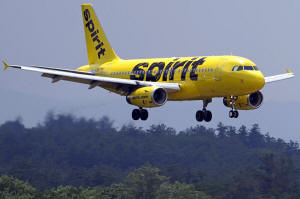Spirit Airlines files for bankruptcy as financial losses pile up and
debt payments loom
 Send a link to a friend
Send a link to a friend
 [November 19, 2024] By
DAVID KOENIG [November 19, 2024] By
DAVID KOENIG
Spirit Airlines said Monday that it has filed for bankruptcy protection
and will attempt to reboot as it struggles to recover from the
pandemic-caused swoon in travel, stiffer competition from bigger
carriers, and a failed attempt to sell the airline to JetBlue.
Spirit, the biggest U.S. budget airline, filed a Chapter 11 bankruptcy
petition after working out terms with bondholders. The airline has lost
more than $2.5 billion since the start of 2020 and faces looming debt
payments totaling more than $1 billion in 2025 and 2026.
The airline said it expects to continue operating normally during the
bankruptcy process. Spirit told customers Monday they can book flights
and use frequent-flyer points as they ordinarily would, and said
employees and vendors would continue getting paid.
The airline said it received commitments for a $350 million equity
investment from existing bondholders and will convert $795 million of
their debt into stock in the restructured company. The bondholders will
also extend a $300 million loan that, combined with Spiritís remaining
cash, will help the airline get through the restructuring.
The airline's shares dropped 25% on Friday, after The Wall Street
Journal reported that the airline was discussing terms of a possible
bankruptcy filing with its bondholders. Spirit, based in Dania Beach,
Florida, missed a deadline for filing its third-quarter financial
results but announced that its operating margin would indicate a bigger
loss than the company had in the same quarter last year.

Those were just the latest in a series of blows that have sent the stock
crashing down by 97% since late 2018 ó when Spirit was still making
money.
CEO Ted Christie confirmed in August that Spirit was talking to advisers
of its bondholders about the upcoming debt maturities. On Monday, he
called the deal with bondholders ďa strong vote of confidence in Spirit
and our long-term plan.Ē
People are still flying on Spirit Airlines. Theyíre just not paying as
much.
In the first six months of this year, Spirit passengers flew 2% more
than they did in the same period last year. However, they are paying 10%
less per mile, and revenue per mile from fares is down nearly 20%,
contributing to Spiritís red ink.
Itís not a new trend. Spirit failed to return to profitability when the
coronavirus pandemic eased and travel rebounded. There are several
reasons behind the slump.
Spiritís costs, especially for labor, have risen. The biggest U.S.
airlines have snagged some of Spiritís budget-conscious customers by
offering their own brand of bare-bones tickets. And fares for U.S.
leisure travel ó Spiritís core business ó sagged this summer because of
a glut of new flights.
[to top of second column] |

A Spirit Airlines 319 Airbus approaches Manchester Boston
Regional Airport for a landing, Friday, June 2, 2023, in Manchester,
N.H. (AP Photo/Charles Krupa, File)
 The premium end of the air-travel
market has surged while Spiritís traditional no-frills end has
stagnated. So this summer, Spirit decided to sell bundled fares that
include a bigger seat, priority boarding, free bags, internet
service and snacks and drinks. It also dropped cancellation fees
after rival Frontier Airlines did so.
Those were huge changes from Spiritís longtime strategy, which
focuses on grabbing customers with rock-bottom fares and then
getting them to pay extra for things that are free on many other
airlines, such as bringing a carry-on bag or ordering a soda.
In a highly unusual move, Spirit planned to cut its
October-through-December schedule by nearly 20%, compared with the
same period last year, which analysts said should help prop up
fares. But that would help rivals more than it would boost Spirit.
Analysts from Deutsche Bank and Raymond James say that Frontier,
JetBlue and Southwest would benefit the most because of their
overlap with Spirit on many routes.
Spirit has also been plagued by required repairs to Pratt & Whitney
engines, which is forcing the airline to ground dozens of its Airbus
jets. Spirit has cited the recall as it furloughed pilots.
The aircraft fleet is relatively young, which has made Spirit an
attractive takeover target.
Frontier tried to merge with Spirit in 2022 but was outbid by
JetBlue. However, the Justice Department sued to block the $3.8
billion deal, saying it would drive up prices for Spirit customers
who depend on low fares, and a federal judge agreed in January.
JetBlue and Spirit dropped their merger two months later.
U.S. airline bankruptcies were common in the 1990s and 2000s, as
airlines struggled with fierce competition, high labor costs and
sudden spikes in the price of jet fuel. PanAm, TWA, Northwest,
Continental, United and Delta were swept up. Some liquidated, while
others used favorable laws to renegotiate debts such as aircraft
leases and keep flying.
The last bankruptcy by a major U.S. carrier ended when American
Airlines emerged from Chapter 11 protection and simultaneously
merged with US Airways in December 2013.
All contents © copyright 2024 Associated Press. All rights reserved
 |